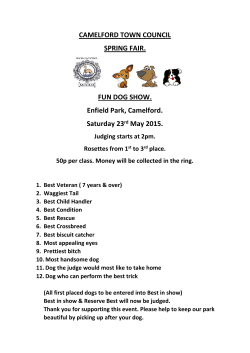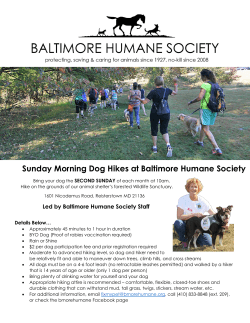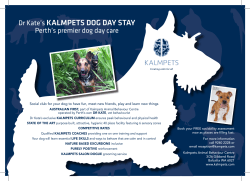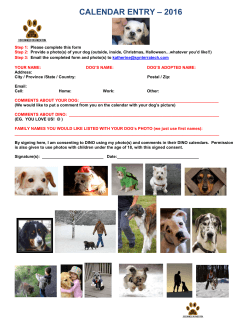
Galloping Breed Published in the Doberman Digest
VANDIVERSIONS The Doberman is a short backed galloping dog?? The phrase “the Doberman is a short-backed galloping dog” has been in use for many years. Anyone who has been showing Dobermans for any length of time has heard this. Being the eternal skeptic and of analytical mind, I have always questioned the validity of this statement. To classify the Doberman as a galloping breed should put it into a class that truly excels in that gait. The gallop is the fastest speed at which a dog can travel. Below are figures showing the proportions of a Doberman and of a Whippet, which is very similar to a Greyhound. Both of the Whippet and Greyhound are used in professional dog races because they are the best gallopers. The sight hound owns the title of ultimate galloper. If we compare the Doberman structure to that of a true galloper, we find significant differences. The Doberman leg length is equal to the body depth. This is shown by the horizontal line drawn through the elbow that is exactly half of the height of the square. The dotted lines that represent the leg length in the Whippet drawing are of equal length. They clearly show that the sight hound’s leg length is greater than the body depth. The Doberman standard calls for heavy bone. Sight hounds have lighter bone and are built more lightly overall. (Whippet standard "moderate bone throughout.") You can see by the angles in the graphic that the Doberman is well angulated with a 90 degree front. Sight hounds typically have more open angles as can be seen in the depiction of angulation in the Whippet drawing. The topline of a Doberman is straight and the tuckup is moderate, while the sight hound's topline is well arched and he has a much higher tuckup. The sight hound body allows for a very flexible back so that the back and rear can fold more fully under the dog. Curtis Brown states in his book1 “Speed can be increased by lengthening the stride or by increasing the frequency,” The sight hound lengthens stride with longer legs. Mr. Brown’s book1 also allows that “the length of the stride can be increased by … flexing and extending the back.” The sight hound's ability to fold completely under and fully open the body results in a longer stride. Sight hounds have longer legs, a more flexible body, more open angulation and lighter bone. These are major differences between the Doberman and the ultimate galloping dog. Now that we see the differences in the Doberman and the ultimate galloper, how about a comparison of the Doberman and breeds with a different natural gait? The Dalmatian is arguably the ultimate trotting dog. Their job was to accompany carriages over long distances at a trot. Their standard states "The Dalmatian is capable of great endurance with a fair amount of speed." The Doberman standard calls for "great endurance and speed." Hmmm ... pretty similar. These comparisons certainly question that "the Doberman is a short backed galloping dog." In the Curtis Brown book1, he states "It was man's desire to develop dogs with greater speed that caused him to select towards greater back flexibility with longer legs as found in the Greyhounds and Whippets." The Dalmatian drawing shows a nearly square dog with leg length equal to body depth. The angulation appears similar to that of the Doberman. (Dalmatian Standard says " shoulders are smoothly muscled and well laid back. The upper arm is approximately equal in length to the shoulder blade and joins it at an angle sufficient to insure that the foot falls under the shoulder." Sounds similar to the Doberman Standard, doesn't it? The Dalmatian also has a straight back and a moderate tuckup. The standard also calls for "good substance and is strong and sturdy in bone." These characteristics are very similar to the Doberman. My version is that the Doberman is much more similar in body type to a Dalmatian than to a Whippet. OK, how about another breed ... the Rottweiler. Yes there are differences in proportion and substance, but there are many similarities in other structural features. Again, we have a dog with leg length equal to body depth, similar shoulder and rear assembly, a straight back and less tuckup. In the Gait section, the Rottweiler standard states " The Rottweiler is a trotter." There is no question that the Doberman is short backed. Curtis Brown also says1 ."A short body aids endurance at the gallop and improves speed in dorsostable animals." (Dorsostable means a stable back). We all know that the Doberman is a quick and agile athlete. Observing a Doberman at an all-out run is a pleasure. It fills us with joy as he flies across the ground. Few would argue that the Doberman is a natural at the double suspended gallop. In my opinion, the Doberman executes well at the gallop ... and the trot ... and the cantor ... and the walk. He is an all-round dog, that is not defined by any one specific speed. One of the elements that defines breed type is the gait (more on that in the future). To represent the Doberman as a short backed galloper sets an expectation of a dog that moves like, and therefore is probably built like, the ultimate galloper ... the sight hound. Let's just say "the Doberman is a short-backed dog" and not define him as a galloper. That's my version. Bob Vandiver 1 Dog Locomotion and Gait Analysis Curtis M. Brown 1986 Hofflin Publishing
© Copyright 2025









